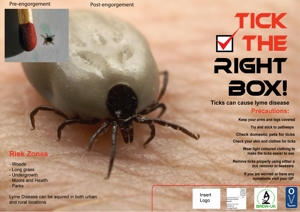Energy, enthusiasm and determination both speakers at the Professional Women in Pest Management (PWIPM) meeting held during PestTech last Wednesday (3 November) had plenty of all three. Their presentations on ticks and the use of falcons in pest control attracted an excellent crowd.
Tick the right box
First up was Elinor Bright who is currently in the third year of an environmental health degree. Elinor has been researching the incidence of Lyme disease in Wales and the awareness of the risk among people who may be exposed, occupationally and recreationally, to the disease. Un-phased when the PowerPoint technology failed, she spoke without visual aids, explaining how Lyme disease is spread by infected ticks and how, unless treated early, it can be a serious threat to people’s health. Groups at risk include Environmental Health Officers, pest controllers, farmers, forestry workers, deer handlers, gamekeepers and others who work in the countryside as well as walkers, cyclists and so on who use the countryside for their recreation.
|
The research, which has been supported by the CIEH in Wales and Powys CC, revealed a widespread lack of awareness of the problem among both employees at risk and their employers. Of the 22 local authorities surveyed just two demonstrated any awareness of the potential risk. One had a written risk assessment and the other had a card which was given to exposed staff for their GPs, should the need arise. Elinor also contacted a number of other organisations who employ people who might be exposed to Lyme disease. This included the Forestry Commission, the National Trust and the Countryside Commission for Wales (CCW). Of these only the CCW came forward with any information. This was in the form of a ‘fact sheet’ supplied to employees. To test what information was available for the general public a secret shopper email was sent out to the local authorities and other organisations as if from a member of the public. This time, 15 authorities responded – most referring to the BADA-UK or other Lyme disease website. BADA-UK is a charity, run by volunteers, to raise awareness of the dangers of tick bites and the diseases that may result from them. Of the organisations contacted, once again only the CCW provided any information – this was the same ‘fact sheet’ as for occupational exposure. With such widespread lack of awareness Elinor set about producing a leaflet and poster using the title ‘Tick the right box’ to help address the information gap. These not only raise awareness but also provide excellent guidance on what to do if you are bitten. |
|
|
|
She has also been involved in a wider communications effort appearing on ITV Wales News, the BBC Wales consumer programme, X-Ray as well as in articles in the welsh daily newspaper, the Western Mail and trade magazines such as Today’s Technician and Environmental Health News. A copy of Elinor’s presentation which includes copies of the leaflet and poster can be downloaded from the PWIPM website. Controlling bird with birds Layla explained how she has always has an interest in birds of prey. As a small child in mid-Wales she built a bird table with her father and spent many a happy hour watching the little birds but even then, when the sparrow hawk came through, she was fascinated by the power it had over all the other birds. “All the small birds went silent when the sparrow hawk came through and even if she was successful and the visit meant one less small bird to watch I couldn’t help but be impressed,” she said. Flying hawks or falcons is a natural and extremely environmentally-friendly way of controlling pest species – in Layla’s case that’s primarily gulls and feral pigeons – and it’s highly effective. “But I’m a bird controller not a pest controller,” she said. “Bird dispersal,” she explained, “can be used for landfill, airfields, industrial sites, town centres and farmland. However every site is different which is why we offer a free site survey.” The business has expanded and currently has 32 breeding pairs of noisy birds. “Fortunately we are based on an 8.5 acre site in the middle of the countryside, so that’s not a problem,” she said. “The birds can be trained to be quieter but, to be honest, when you’re using them to control other birds you want a vocal bird – it’s all part of the deterrent,” she added. In addition to the pest control business, Hawksdrift also runs falconry demonstrations throughout England and Wales and is involved in the conservation, protection and rehabilitation of wild birds of prey, working closely with organisations like the RSPB on a voluntary basis. One of the big problems for PWIPM at PestTech is that the event is just too busy. Many of the women who would like to go along to the session simply cannot get away from their stands. Fortunately we understand that Layla has agreed to speak again at the next national PWIPM event which will be held during PestEx in London in April next year. Watch this space for details Original idea Whilst the chance of a chat and an exchange of ideas in an informal setting is an enjoyable experience it seems that a British audience needs something extra. The success of this year’s PestTech meeting has shown that adding a more formal educational element to the mix works extremely well. The session even attracted a number of ‘honorary woman’. Indeed, the men who came along were made very welcome since the intention of PWIPM is not to exclude male colleagues but rather to provide something which is led by women and run to suit the needs of women who work in pest management. If that happens to coincide with what the men are interested in then all well and good. |
||



